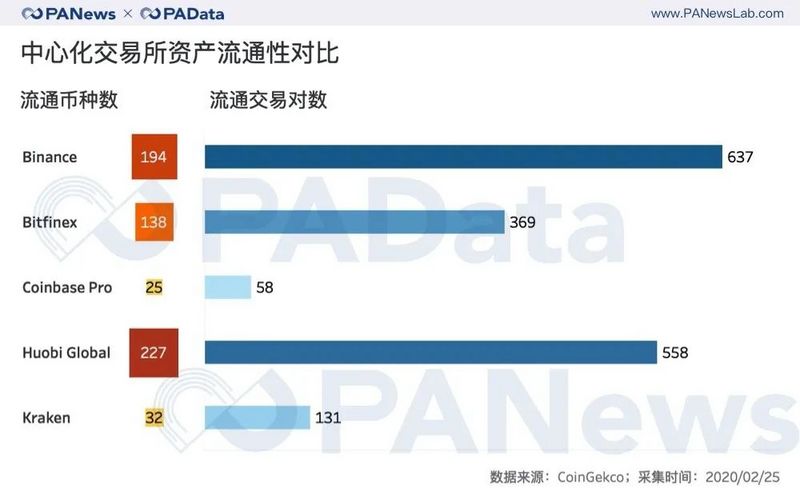Forgotten crypto assets: daily trading volume of over 5000 tokens only accounts for 2% of the market

Analyst | Carol Editor | Bi Tongtong | PANews
The "Eight and Eighth Law" is also called the "Key Minority Rule." The most important is often the 20% minority. In the crypto market, this "monopoly" effect of the head is more obvious.
According to data collected by CoinMarketCap on February 25, there are currently 5146 cryptocurrencies in the world with a total market value of more than US $ 260 billion and a 24-hour nominal transaction volume of US $ 166.9 billion. Among them, the top 10 cryptocurrencies by market capitalization have a total market value and total daily transaction volume of more than 85%. In other words, about 0.2% of cryptocurrencies already have a market share of more than 80%.
- How does the blockchain technology solution fit into the industrial ecology? 丨 Babbitt Industry Welcome Class
- For the record, shake the "mask", resume work monitoring, the blockchain can be used in this way
- The United Nations actively embraces blockchain and has used the technology to achieve tangible results
In highly concentrated markets, the eyes of practitioners and investors are always chasing these head assets, while ignoring the larger number of long tail assets. Many long-tail assets are on the verge or even "dead" because of few listed exchanges, low trading volume, and poor liquidity.
This was originally a natural phenomenon in the competitive market, but the recent DeFi Lego arbitrage incident has revealed the potential risks of low-liquid assets, which makes it necessary to re-examine the status of low-liquid assets.

Over 5000 long-tail assets account for only 2.08% of daily transaction volume
According to CoinMarketCap statistics, on February 25, the total market value of the global cryptocurrency market was approximately 269.366 billion U.S. dollars, and the daily transaction volume was approximately 166.907 billion U.S. dollars. PAData counts the market value and transaction volume of the top 500 cryptocurrencies by market value on the day. The results show that Bitcoin with the largest market value accounts for 62.30% of the total market value of cryptocurrencies, and the transaction volume accounts for 26.08% of the total transaction volume. If the top 30 cryptocurrencies by market capitalization are considered as head assets, the market value of head assets accounts for 92.68% of the total market capitalization, and the currency with transaction volume accounting for 95.17% of the total transaction volume.

And regardless of the market value or transaction volume ratio, the trend of decreasing margins with market capitalization is more obvious. The market value of waist assets ranked 31 to 100 in terms of market capitalization is only 6.16%, and the transaction volume ratio is only 5.47%. It is far from the head assets, but it is still far ahead of the long-tail assets after the market capitalization of 100.
According to statistics, the market value of long-tail assets after the 100th largest market capitalization accounted for about 4.59%, while the transaction volume accounted for only 2.08%. The number of these assets reached 5,046.
The small transaction volume and insufficient liquidity are the main problems of these long-tail assets. They are also one of the main reasons for the crowdsourcing website Dead Coins to judge the "death" of the token. Other reasons include the website's abandonment, no nodes, and social network suspension. In other words, if the transaction volume of tokens is kept at a very low level, problems such as website abandonment and node downtime will also occur.

At present, Dead Coins has included 1867 kinds of "dead coins". After preliminary cleaning of PAData (removal of duplicate or abnormal data), it has been found that there are a total of 947 kinds of tokens that have clearly died, accounting for about 20% of long-tail assets.

40% of centralized exchanges trade less than $ 10,000 per day
How many long-tail assets are in a centralized exchange? What is the volume of these long-tail assets?
PAData counts the current macro-asset liquidity status of the five high-volume exchanges, Binance, Bitfinex, Coinbase, Huobi, and Kraken.
Judging from the number of currency in circulation and the number of trading pairs, Binance and Huobi have a greater breadth of asset circulation. Binance listed 194 tokens, opened 637 trading pairs, Huobi listed 227 tokens, and opened 558 trading pairs. The number of assets listed on Coinbase and Kraken is much smaller. The two exchanges have listed 25 assets and 32 assets, respectively, and have opened 58 trading pairs and 131 trading pairs.

After further statistics, it can be seen that among these circulating assets, long tail assets actually constitute the main aspect of the macro liquidity of the exchange. Binance, Bitfinex and Huobi, which have a large number of listed currencies, all circulate a large amount of long-tail assets. The number of long-tail assets of the three exchanges reached 123, 109, and 156, accounting for 63.40%, 78.98%, and 68.72%.

In general, it is very convenient to trade tokens in centralized exchanges at present, because the trading pairs opened by exchanges are already very extensive, and because of overlapping assets, investors can choose the exchange-traded assets. A total of 30.14% of the assets listed on the five exchanges Binance, Bitfinex, Coinbase, Huobi and Kraken are overlapping, and 23.10% of the listed trading pairs are overlapping.
From the perspective of the trading volume of the trading pairs, of the 1,753 trading pairs of the five exchanges, 40.53% of the trading pairs have a daily trading volume of less than $ 10,000 (excluding NULL), and these trading pairs are less than $ 10,000. Of these, transaction pairs involving long-tail assets account for the vast majority.

For example, Bitfinex has 208 trading pairs with a trading volume of less than 10,000 US dollars, which involves long tail assets, accounting for 74.02% of all trading pairs below 10,000 US dollars. Huobi's value is also relatively high, reaching 78.90%.
Long tail assets support the "facade" of the exchange's macro-liquidity indicators, but the sluggish trading volume proves that the current market scale cannot support this "facade".

Only 50 assets have traded more than $ 10,000 on DEX
The decentralized exchange (DEX) is mainly rooted in the Ethereum public chain, and the assets circulating on it are mainly ERC20 tokens and Ethereum. PAData counts the macro liquidity of the five DEXs with large trading volumes: Bancor, IDEX, Kyber, Oasis DEX and Uniswap. Among them, Uniswap and IDEX have better liquidity. They listed 247 and 245 tokens respectively, and opened 410 and 250 trading pairs. Uniswap uses a capital pool market-making model. In theory, as long as assets with a certain capital reserve can be traded, the availability and convenience of asset trading will be better than the pending order-making market-making model.

Taking a closer look at the asset overlap between the exchanges, it can be found that the breadth of DEX's circulating assets has grown significantly compared to mid-2019. At present, the overlap rate of the circulating tokens of the five exchanges is about 23.92%. When PAData counted a larger range of 10 exchanges in August 2019, this value was only about 5.7% (refer to the "DEX Breakout Campaign" : Talking about asset liquidity and user base ". The overlapping rate of trading pairs is a bit lower. The 5 exchanges currently have 835 trading pairs in circulation, of which 147 are overlapping, and the overlapping rate is 17.60%. This means that users now use DEX The trade fair is much more convenient than half a year ago.

According to Alethio's statistics on the daily trading volume of 75 types of assets, the largest trading volume of all DEX in Ethereum is DAI. The daily trading volume calculated on February 25 is about 4.4098 million USD. Secondly, cUSDC (Compound Package) The daily trading volume also exceeds 1 million, which is about 1.0399 million US dollars. In addition, there are 17 assets including MKR, LINK, WETH, ETH, USDT, sETH, SAI, REP and WBTC with daily trading volume of more than 100,000 US dollars. There are 50 types of assets with a transaction value of more than US $ 10,000, and the lowest asset value is DNA, which is less than US $ 3,500. In addition, there are relatively few asset traders with a transaction volume of less than 10,000 US dollars, and most of them have less than 10 people.

It can be speculated that although DEX's circulating assets are relatively abundant, just like centralized exchanges, there are more long-tail assets with low circulation.
From the perspective of trading pairs, the proportion of trading pairs with a daily trading volume of less than 10,000 US dollars reached 83.47%, the proportion of more than 100,000 US dollars was only 2.51%, and the value of more than 1 million US dollars was only 0.36%.

From this point of view, the trading volume of the entire DEX is still small, and low-liquidity assets account for the majority. Transactions are mainly concentrated on individual assets, such as DAI, cUSDC, KNC, MKR, and LINK in multiple DeFi application scenarios.
According to zumzoom statistics, the largest DEX Uniswap currently has a total capital pool of more than 28 million, which is about 1/77 of the Bitcoin assets on the Binance chain. In the past three months, sETH and MKR accounted for a relatively high pool of funds, reaching an average of 32.74% and 15.08%, respectively.

The WBTC funds pool used by the attackers in the Lego arbitrage incidents of Compound, dydx, Kyber, Uniswap, and bZx accounted for only 2.53%, which was approximately $ 674,400. However, the size of this funding pool is not small in Uniswap, ranking 11th, which is a medium size. If assets of this size can be easily broken by an attacker, the range of potentially risky assets in DEX will cover the vast majority of assets.
The Lego combination between applications can indeed inject new vitality into DeFi, but it should consider the risks that asset size and actual liquidity may bring to product innovation.
We will continue to update Blocking; if you have any questions or suggestions, please contact us!
Was this article helpful?
93 out of 132 found this helpful
Related articles
- Babbitt Original | Zeroing out, getting rich in the market, do you know these three big futures players?
- Live broadcast playback: FCoin Thunderstorm, how to get your money back? | 8 big events
- Gartner lists 6 ideas that hurt digital business, also applies to blockchain
- Glue Manifesto: How can a centralized system better help decentralized systems evolve?
- Can the community restart and can the losses be recovered? 8 big events to clarify the way for FCoin to defend your rights
- QKL123 market analysis | After bitcoin plunges, the halving market is over? 73 days countdown! (0228)
- Hong Kong and Abu Dhabi amend cryptocurrency regulations in conjunction with Financial Action Task Force






